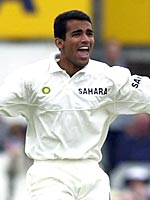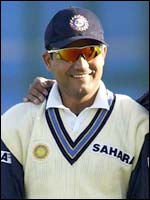India waxed and waned in 2002 in a manner calculated to puzzle even followers of the turf, used to the vicissitudes of sport. Seldom in a single year could a team have batted with the brilliance seen at Leeds and Lord's, inspired performances that brought to mind the upsetting of the Australians a few months previously, and the feebleness seen in New Zealand, where this same line-up, give or take a Sachin, could not muster the most miserable total on lively pitches.
During the season India's batsmen seemed assured and worthy of the high ranking bestowed upon them by the cricketing community at large, for India was not alone in mistaking style for substance. Towards the end, a supposedly mighty top order had been reduced to a bunch of nervous Nellies without the skill or heart needed to score runs in demanding conditions.
 Inevitably, the batting is the focal point of all discussions about this Indian team. Sourav's team rises or falls by its ability with the willow. Of course, the bowling lacks penetration, except on the dustbowls of Delhi, and Zaheer khan alone enhanced his reputation as the year went by. Zaheer is a strong pace bowler, capable of taking wickets on any surface in any part of the world. Unfortunately, he fought a lone battle amongst the leather-flingers.
Inevitably, the batting is the focal point of all discussions about this Indian team. Sourav's team rises or falls by its ability with the willow. Of course, the bowling lacks penetration, except on the dustbowls of Delhi, and Zaheer khan alone enhanced his reputation as the year went by. Zaheer is a strong pace bowler, capable of taking wickets on any surface in any part of the world. Unfortunately, he fought a lone battle amongst the leather-flingers.
Naturally, debate raged as to the merits of this confusing Indian outfit.
Which was the real India? The team that chased a record score at Lord's, overcame the West Indians in Trinidad and secured a daring victory at Headingley? Or the feckless side that performed so tamely in New Zealand?
Alas, the answer is that they are all India, all part of the mix, and therein can be found the frailties that will continue to hold back Indian cricket.
India has only three cricketers resourceful enough to play as well overseas as in their own backyard. Sachin Tendulkar, Rahul Dravid and Zaheer Khan. The rest are creatures of time and place.
India's year began well with the country's first Test win in the Caribbean since the famous run chase of the 1970s, an event that persuaded their opponents that pace was the answer. This victory in Port of Spain raised hopes that India could cast aside its reputation as a side formidable amongst the familiar and all at sea elsewhere. Ganguly's team arrived in England full of ambition and youthful endeavour.
Despite losing the first Test amidst the cold and rain of an English summer, the tourists fought back and the series ended with their opponents running for cover. Rahul Dravid was the outstanding batsman of the summer with a performance that combined high levels of skill with uncommon tenacity. Alongside Sanjay Bangar and, later, Tendulkar, this cultured batsman took the sting out of an England attack that had been expecting to take wickets on a cloudy, dark first morning and upon a pitch favouring swing and seam.
Many teams have packed in the cards in conditions of this sort, and not only bewildered visitors from the Indian ocean. Moreover, India had dared to play to its own strength by choosing to risk the elements by batting after winning the toss.
Hereabouts, Indian cricket seemed to be moving confidently along under resolute leadership. Ganguly's teem seemed fresh and united and further glories were anticipated. Optimists were cheered by a spirited performance in the final of the 50-over competition in which the younger Indian batsman took their team to victory against overwhelming odds and despite England setting the stiffest of targets. Suddenly, there was loose talk about a renaissance and a World Cup win. India has not always managed to keep its head when things are going well.
 These triumphs camouflaged weaknesses that were bound sooner or later to be exposed. After years of trying India still could not find a reliable man to open the innings. The story of Virender Sehwag was the story of the year; brilliant in patches but headstrong and unproductive when the chips were down. Sehwag has the technique to succeed but not the tightness required. He must be told that it is not enough to score runs now and then, and that one-day cricket may create sporting heroes but time is a better judge of a batsman's standing. Shakespeare is not judged by his comedies.
These triumphs camouflaged weaknesses that were bound sooner or later to be exposed. After years of trying India still could not find a reliable man to open the innings. The story of Virender Sehwag was the story of the year; brilliant in patches but headstrong and unproductive when the chips were down. Sehwag has the technique to succeed but not the tightness required. He must be told that it is not enough to score runs now and then, and that one-day cricket may create sporting heroes but time is a better judge of a batsman's standing. Shakespeare is not judged by his comedies.
Nor could India produce a mature keeper/batsman or any pacemen capable of giving Zaheer the support he needs. Accordingly, Javagal Srinath was lured form his rest, a faithful servant whose reappearance told the tale.
Harbhajan has been bowling well, and considering his age and difficulties, his efforts have been praiseworthy. India must find more bowlers as accomplished and energetic.
After the promise of spring and summer came the discontent of winter. At times it seems that overseas performances have stopped mattering. Bad as India have been in New Zealand, Pakistan and Sri Lanka have been worse.
Perhaps thoughts had strayed to the World Cup, or perhaps wealth had made some players lazy and not as proud as their forefathers. Whatever the causes, these lamentable defeats blight the records of supposedly powerful teams.
The year ended as it had begun, with Ganguly edging into the slips, his position in doubt and his team weak in important areas. Of course, the administration is partly to blame because it concentrates more upon glory and money than upon building a structure strong enough to produce players with the characters, experiences and resources required to succeed in hail and shine.
The attitude of the Indian board was revealed in its dispute with the players over sponsorship and contracts. After all these years still these officials do not realise that they are servants of the game and not its feudal lord. Indian cricket has been put in their trust and they are accountable for its failures.
Not a bad year overall, with some fine victories and fine cricketers emerging. Dravid was man of the year. But the old fallibilities remain unresolved, preventing Indian cricket reaching its potential. India will continue to enjoy some great days but without fundamental changes off the field it is hard to see the good times lasting.
Meanwhile, there is Sachin, Zaheer, Dravid and, sometimes, Sehwag and Laxman, and the illusion that the mountain is easily climbed. Sacrifices and wisdom are needed, and the search for them is destined to continue for another 12 months.
Winning the World Cup remains possible because this is a talented team, but it might prove a distraction to the greater purpose of turning India into a cricketing stronghold beyond the packed stands and television figures.







 © 2025 Rediff.com -
© 2025 Rediff.com -